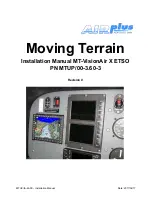
COMPETINO Manual
- 15 -
6 GPS Functions
The use of GPS receivers has become indispensable for navigation today. A chain of
satellites continually circles the Earth. It is possible to determine your position very precisely
anywhere in the world by receiving several satellites at the same time.
6.1 Assessment of Reception Quality
The integrated GPS Receiver can follow up to 16 satellites at the same time. After turning on
the unit it is necessary to receive at least 4 satellites to fix your position for the first time.
Once logged on, 3 satellites (for 2D positioning) are sufficient for further navigation.
However, if you want to record altitude as well (3D positioning), then four satellites are
required. For competition flights it is always necessary to have 3D positioning. There is a
table in the receiver (The Satellite Almanac) in which the path, place, and time of all satellites
are kept with reference to the receiver. The Almanac is continuously updated during signal
reception. However, if the signal to the Almanac memory is disrupted completely or the unit
is taken 200 km or more from the last reception point, then the Almanac has to be re-
established (which can take several minutes). Power is still supplied to the Almanac’s
memory even when the unit is turned off.
If the receiver is turned off for only a short period of time (less than 2 hours), it takes less
than a minute to determine the location. Buildings, mountains or thick forest affect reception
quality, therefore, you should always look for the best possible visibility around you with the
antenna under the
COMPETINO
label pointing upwards. When the unit is securely mounted
(to a flight deck, etc.), it should not have more than 45° deviation from a horizontal position.
Because the receiving strength of the satellite signal is only 1/1000 of mobile radios, these
radio receivers and other disruptive factors (like notebooks) should be kept as far away as
possible from the
COMPETINO
.
Together with the navigation signal, information about the number of received satellites is
shown on the uppermost right side of the display (directly across from the battery bar
graphs). One angle is equal to one satellite with good reception. The longer the bar, the
better the reception.
6.2 Compass and Flight Direction
In contrast to a normal magnetic compass which is oriented to magnetic north, the GPS
compass can show direction
only
when the user is moving over ground. However, it has the
advantage that it is not subject to any grid deviation and does not show any deviation as a
result of iron or any magnetic material. Its zero point always corresponds with true
geographic north
(0 or
360 degrees).
The course that is the flight direction
(= Track
) is
calculated from your movements.
If the user remains stationary at the same location, then the course and compass needles
are inoperative. The exact course (that is the direction in which the user travels over ground)
is always at the top of the compass, but can also be read in the display “
Track
”.
When
circling in a thermal the compass rose appears to turn; in reality the needle does not move;
the unit along with the aircraft, moves around the rose itself.







































